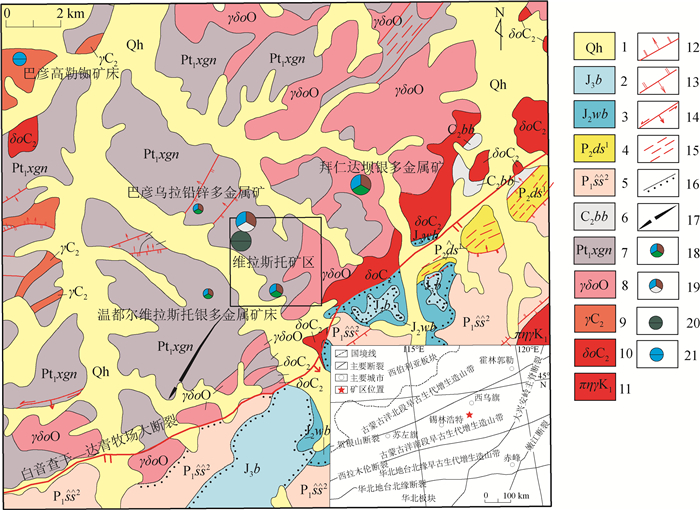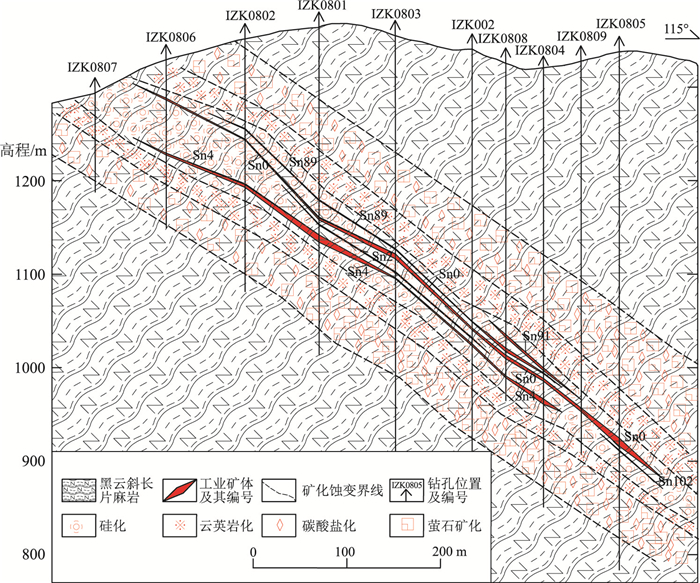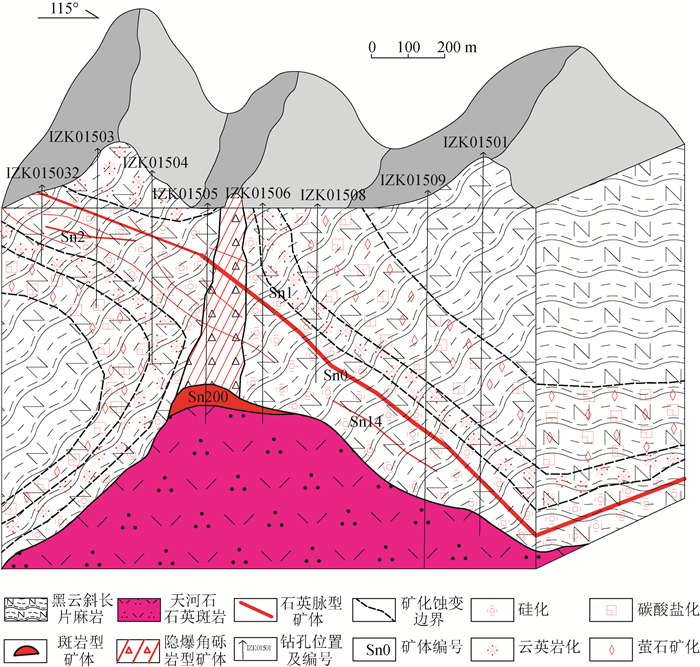Research on the zoning and distribution of ore-bearing tectono-deformation-lithofacies belt in the Weilasituo Li-Sn polymetallic deposit, Inner Mongolia
-
摘要:
内蒙古自治区克什克腾旗维拉斯托矿区是近年新发现的大型锂锡多金属矿床。矿区深部为Sn、Zn、Rb、Nb、Ta等成矿元素为主体的强云英岩化、天河石化花岗斑岩型矿(化)体;中部为以Li元素为主、伴生Sn、Mo等成矿元素的隐爆角砾岩型矿(化)体;浅部为Sn、W、Zn、Cu、Mo、Ag等成矿元素的热液脉状矿(化)体。多金属矿化受断裂和岩浆热液蚀变双重控制。断裂蚀变分带实测剖面显示,以断裂为中心,两侧蚀变分带对称分布,依次发育硅化、云英岩化、萤石化和碳酸盐化,由此确定蚀变分带:①内带为硅化蚀变岩相带,宽度在2~5 m之间,矿体硅化强度高,围岩也发育硅化,浅色矿物变多,暗色矿物减少,岩石变硬变脆,局部可见石英小细脉;②中带为云英岩化蚀变岩相带,宽度在5~10 m之间,云英岩化带发育在硅化带外侧,在矿体与围岩接触部位一般发育结晶粒度较大的云母片,其他部位的云母为细粒类型,包括锂云母、白云母、金云母、绢云母等;③外带为萤石-碳酸盐化蚀变岩相带,宽度一般在20~30 m之间,较大者可达100 m以上;萤石-碳酸盐化蚀变带距矿体较远,多数以细脉状或薄膜状填充在围岩裂隙中。通过对该矿床含矿构造变形岩相带三维空间分布特征的研究,建立起该区构造变形岩相成矿和找矿模型,为下一步地质勘查工作提供新的地质依据。
Abstract:The Weilasito Li-Sn polymetallic deposit has been discovered in Hexigten Banner, Inner Mongolia. The deep part of the deposit consists of greisen and amazonite altered quartz porphyry type ore with Sn, Zn, Rb, Nb and Ta. The middle part is composed of cryptoexplosive breccia cylinder type ore (mineralized spot) with Li and associated metallogenic elements such as Sn and Mo. The shallow part has the hydrothermal vein-type Sn, W, Zn, Cu, Mo and Ag ore. The polymetallic mineralization is controlled both by fractures and magmatic hydrothermal alteration. The measured profile of the mineralized fault alteration belt shows that the alteration zone is symmetrically distributed on both sides of the fault. From the fault center, silicification, greisenization, fluoritization and carbonatization are developed in sequence, thereby determining the alteration zones: ①The inner part is a silicified alteration facies zone with a width of 2~5 m. The orebodies and the surrounding rocks have been silicified. The light-colored minerals increase, the dark-colored minerals decrease, the rock becomes harder and more brittle, and small quartz veins are locally visible; ②The middle part is a greisenization altered facies zone, with a width of 5~10 m. The greisenization zone is developed outside the silicified zone, and larger mica granules are generally developed at the contact part of the orebody and surrounding rocks, other parts of the mica are of fine-grained types and consist of such rocks as lepidolite, muscovite, phlogopite and sericite; ③The outer part is a fluoritization-carbonatization altered facies zone, generally with the width of 20~30 m, and the larger one can reach more than 100m; the fluoritization-carbonatization alteration zone is far away from the orebody, and most of them fill the fissures of the surrounding rocks in the form of veins or films. Sometimes it is not easy to distinguish and divide them due to the superposition of other mineralization alterations. Through the study of the three-dimensional characteristics of ore-bearing tectono-deformation-lithofacies zone, a typical ore-prospecting model is established to provide geological basis for the exploration in this region.
-
致谢: 中国地质调查局发展研究中心庞振山研究员与笔者一同参与野外调研,内蒙古维拉斯托矿业有限公司王可祥总经理、胡格吉乐吐副总经理在野外提供了帮助,中国科学院地质与地球物理研究所张宝林研究员审阅了全文并给出宝贵的修改意见,在此一并谨致谢忱。
-
图 1 维拉斯托多金属矿区域地质简图
1—第四系沉积物;2—侏罗系白音高老组;3—侏罗系万宝组;4—二叠系大石寨组;5—二叠系寿山沟组;6—石炭系本巴图组;7—古元古界锡林郭勒杂岩;8—奥陶纪云英闪长岩;9—石炭纪花岗岩;10—石炭纪石英闪长岩;11—白垩纪二长花岗岩斑岩;12—正断层;13—逆断层;14—平移断层;15—韧性剪切带;16—不整合界线;17—背斜;18—铅-锌多金属矿床;19—钨-锡多金属矿床;20—锂多金属矿床;21—铷多金属矿床
Figure 1. Simplified geological map of the Weilasituo polymetallic deposit
表 1 成矿期次和成矿阶段划分
Table 1 Division of metallogenic periods and stages
成矿期次 岩浆晚期 热液期 表生期 成矿阶段 花岗斑岩型矿化阶段 石英+斜长石+锂云母+锡石+辉钼矿阶段 石英+锡石+闪锌矿+黑钨矿+辉钼矿阶段 石英+闪锌矿+黄铜矿+方铅矿等硫化物阶段 萤石+碳酸盐阶段 无矿化阶段 矿石构造 斑状构造 角砾状构造 热液交代构造 热液交代构造 热液交代构造 — 矿化组合 Sn-Zn Li2O-Rb2O-Sn-Mo Sn-Zn-WO3-Mo Cu-Zn-Pb-Ag F-CO2 — 矿物组合 锡石、闪锌矿、锡黝铜矿、黝铜矿、毒砂、钠长石、天河石、石英、黄玉、白云母 锂云母、锡石、辉钼矿、石英、斜长石 锡石、锡黝铜矿、圆柱锡矿、闪锌矿、黑钨矿、辉钼矿、毒砂、石英、白云母、绢云母、萤石 闪锌矿、黄铜矿、黝铜矿、方铅矿、毒砂、磁黄铁矿、黄铁矿、辉铋矿、石英、白云母、绢云母、萤石 方解石、石英、萤石、白云母、绢云母 褐铁矿、高岭土、方解石 蚀变类型 钠长石化、黄玉化、硅化、天河石化 硅化、绢云母化、云英岩化、锂云母化 硅化、云英岩化 硅化、萤石化、云英岩化 萤石化、方解石化、绿泥石化、绿帘石化 褐铁矿化、高岭土化、伊利石化 表 2 构造变形岩相分带初步综合方案
Table 2 Preliminary comprehensive plan for the zoning of tectono-deformation-lithofacies belt
原岩类型 岩浆期后热液交代蚀变分带(自矿化中心向外) 黑云斜长片麻岩 硅化黑云斜长片麻岩 云英岩化黑云斜长片麻岩 萤石+碳酸盐化黑云斜长片麻岩 斜长角闪岩 硅化斜长角闪岩 云英岩化斜长角闪岩 萤石+碳酸盐化斜长角闪岩 石英闪长岩 硅化石英闪长岩 云英岩化石英闪长岩 萤石+碳酸盐化石英闪长岩 -
王京彬, 王玉往, 王莉娟, 等.大兴安岭南段锡多金属成矿系列[J].地质与勘探, 2005, 6(5):15-20. http://www.cqvip.com/Main/Detail.aspx?id=20785045 王瑾, 侯青叶, 陈岳龙, 等.内蒙古维拉斯托铜多金属矿床流体包裹体研究[J].现代地质, 2010, 24(5):847-855. http://www.cnki.com.cn/Article/CJFDTotal-XDDZ201005003.htm 潘小菲, 郭利军, 王硕, 等.内蒙古维拉斯托铜锌矿床的白云母Ar/Ar年龄探讨[J].岩石矿物学杂志, 2009, 28(5):473-479. http://d.wanfangdata.com.cn/Periodical/yskwxzz200905007 郑翻身, 蔡红军, 张振法, 等.内蒙古拜仁达坝维拉斯托超大型银铅锌矿的发现及找矿意义[J].物探与化探, 2006, 30(1):13-20, 25. http://www.cqvip.com/QK/95670X/20061/21160097.html 李泊洋, 姜大伟, 付旭, 等.内蒙古维拉斯托矿区锂多金属矿床地质特征及找矿意义[J].矿产勘查, 2018, 9(6):1185-1191. http://www.cnki.com.cn/Article/CJFDTotal-YSJS201806022.htm 吕古贤, 邓军, 郭涛, 等.玲珑-焦家式金矿构造变形岩相形迹大比例尺填图与构造成矿研究[J].地球学报(中国地质科学院院报), 1998, 19(2):177-186. http://www.cnki.com.cn/Article/CJFDTotal-DQXB802.010.htm 吕古贤, 舒斌, 郭涛, 等.胶东阜山金矿床构造变形岩相形迹大比例尺填图[C]//"九五"全国地质科技重要成果论文集, 2000: 25-29. 吕古贤, 郭涛.阜山金矿区构造变形岩相特征与成矿流体构造物理化学特征研究[J].地质地球化学, 2001, 29(3):90-93. http://www.cnki.com.cn/Article/CJFDTotal-DZDQ200103015.htm 吕古贤, 郭涛, 舒斌, 等.构造变形岩相形迹的大比例尺填图及其对隐伏矿床地质预测——以胶东玲珑-焦家式金矿为例[J].中国区域地质, 2001, 20(3):313-321. http://www.cqvip.com/Main/Detail.aspx?id=5432567 吕古贤, 郭涛, 刘杜鹃, 等.矿区构造变形岩相形迹填图、矿化趋势度的实测及其地质找矿[J].地质找矿论丛, 2002, 17(4):217-224. http://d.wanfangdata.com.cn/Periodical/dzzklc200204001 吕古贤, 郭涛, 舒斌, 等.构造变形岩相形迹大比例尺填图与深部外围成矿预测[C]//第八届全国矿床会议论文集, 2006: 693-699. 郭利军, 葛昌宝, 冯贞, 等.内蒙古锡林浩特东部拜仁达坝银铅多金属矿勘查过程及远景评述[J].物探与化探, 2004, 28(5):394-397, 401. http://www.cnki.com.cn/Article/CJFDTotal-WTYH200405004.htm 欧阳荷根.大兴安岭南段拜仁达坝-维拉斯托银多金属矿床成矿作用及动力学背景[D].中国地质大学(北京)博士学位论文, 2013. 祝新友, 张志辉, 付旭, 等.内蒙古赤峰维拉斯托大型锡多金属矿的地质地球化学特征[J].中国地质, 2016, 43(1):188-208. http://www.cqvip.com/QK/90050X/201601/667970009.html 郭贵娟.内蒙古维拉斯托锡多金属矿床地质特征及成因探讨[D].中国地质大学(北京)硕士学位论文, 2016: 1-82. 翟德高, 刘家军, 李俊明, 等.内蒙古维拉斯托斑岩型锡矿床成岩、成矿时代及其地质意义[J].矿床地质, 2016, 35(5):1011-1022. http://d.wanfangdata.com.cn/Periodical/kcdz201605009 -
期刊类型引用(5)
1. 陈炳翰,李鹏,刘建楠. 中国铯矿成矿规律概要. 中国地质. 2024(06): 1946-1959 .  百度学术
百度学术
2. 马岩,陈宣华. 我国“三稀”关键矿产的成矿理论与勘查研究进展. 地质学报. 2023(10): 3475-3492 .  百度学术
百度学术
3. 陈思静,胡祥云,刘双. 内蒙古维拉斯托地区高精度航磁调查与应用研究. 地球科学. 2022(06): 2175-2189 .  百度学术
百度学术
4. Shao-Yong Jiang,Huimin Su,Xinyou Zhu,Kangyu Zhu,Zhenpeng Duan. A New Type of Li Deposit: Hydrothermal Crypto-Explosive Breccia Pipe Type. Journal of Earth Science. 2022(05): 1095-1113 .  必应学术
必应学术
5. 马收先,李厚民,孙燕,陈雷,庞绪勇,张英利,张朋. 湘南地区锡石结晶控制因素——来自阴极发光图像、微量元素和年龄的证据. 地质通报. 2021(10): 1737-1756 .  本站查看
本站查看
其他类型引用(0)




 下载:
下载:



